One day I may post art here. Today is that day. There is art here (under the "my art" tag). she/her or they/them
Don't wanna be here? Send us removal request.
Text
Me watching Indie Cross get popular and watching the general public misgender Ghost/The Knight all over again

#reblog#hollow knight#cw misgendering#see this is another part of why I can't watch hollow knight streams#from people who aren't major players in the fandom#if you can't get the characters' genders right#and are making fun of ME when I go 'hey the vessels are canonically genderless'#then why the fuck would I wanna be there.
899 notes
·
View notes
Photo
guys I'm reasonably certain this is a female with a pouch full of eggs or infants
her babies are the rice upon which she sits
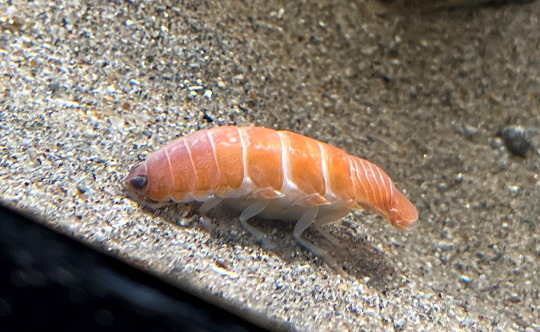
The sushi-shaped isopod is a crustacean like no other.
(Image credit: Aquamarine Fukushima)
#reblog#isopog#sent to me#it would be pretty inconvenient for the species to have to walk/swim around like that normally#you can see how the back plates are stretched out from it#love you forever isopogs#isopoda#sushi babey <3
35K notes
·
View notes
Text
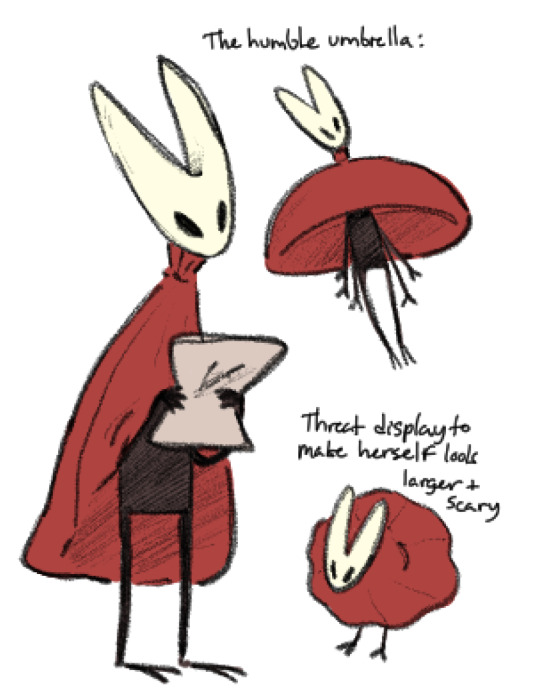
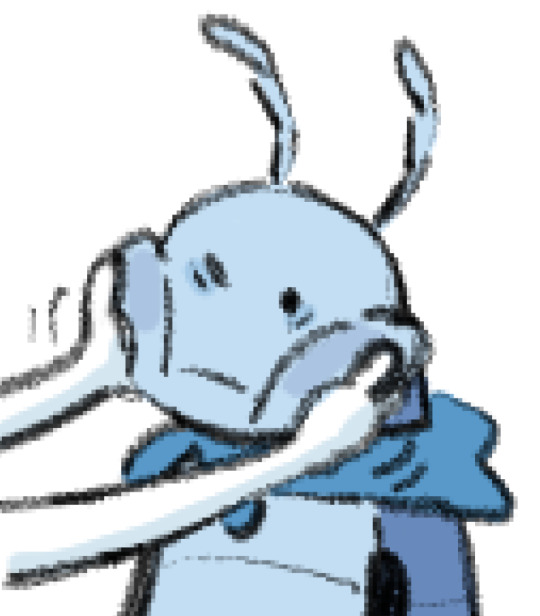
More hornets and another maskless quirrel
1K notes
·
View notes
Text
Round 3 - Reptilia - Sphenisciformes



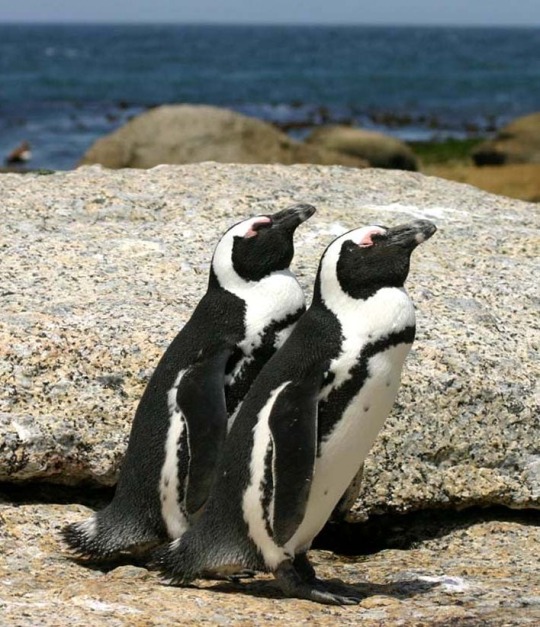
(Sources - 1, 2, 3, 4)
Our next order of birds are the Sphenisciformes, which contain one family, Spheniscidae, commonly called “penguins”.
Penguins are one of the most aquatic birds, highly adapted for life at sea. About half of their life is spent on land, while the other half is spent in the ocean. They are flightless, with wings modified into flippers for swimming. Their feathers are very dense, which help to both insulate the birds in cold water and trap a layer of air to ensure buoyancy. They can drink salt water because their supraorbital gland filters excess salt from the bloodstream, which is then excreted in a concentrated fluid from their nasal passages. On land, penguins either waddle on their feet or slide on their bellies across the snow while using their feet to propel and steer themselves. They also jump with both feet together if they want to move more quickly or cross steep or rocky terrain. Most penguins feed on krill, fish, squid, and other forms of sea life which they catch and swallow whole while swimming, using a spiny tongue and powerful jaws to grip their slippery prey. They live almost exclusively in the Southern Hemisphere; only one species, the Galápagos Penguin (Spheniscus mendiculus), is found north of the Equator. Larger penguins generally inhabit colder regions, while smaller penguins inhabit regions with temperate or tropical climates.
Penguins mostly breed in large colonies, the exceptions being the Yellow-eyed Penguin (Megadyptes antipodes) and Fiordland Penguin (Eudyptes pachyrhynchus). Penguin colonies may range in size from as few as 100 to as many as several hundred thousand, depending on species. Penguins form monogamous pairs for a breeding season, though the rate the same pair recouples the next year varies. Penguins lay one to two eggs in a clutch. Both parents share incubation duties, with the exception of the Emperor Penguin (Aptenodytes forsteri) (image 1), where the male does it all. Incubation shifts can last days and even weeks as one member of the pair feeds at sea. Penguin eggs are smaller than any other bird species when compared proportionally to the weight of the parent birds, but the shell is thick and the yolk is large. Some yolk may remain when the chick hatches, helping to sustain the chick if their parent is delayed in returning with food.
Penguins evolved in the Early Paleocene, around 62 million years ago. There is molecular evidence of an even earlier origin, in the Late Cretaceous.

Propaganda under the cut:
Penguins are named after the Great Auk (Pinguinus impennis), a now extinct, flightless shorebird. “Penguin” was the Spanish, Portuguese, and French name for the species. When European explorers saw what are today known as penguins in the Southern Hemisphere, they noticed their similar appearance to the Great Auk of the Northern Hemisphere and named them after this bird, although they are not closely related.
A group of penguins on land is called a “waddle”, and a group of penguins in the water is a “raft”.
The largest living penguin is the Emperor Penguin (Aptenodytes forsteri) (image 1). On average, adult Emperor Penguins are about 1.1 m (3 ft 7 in) tall and weigh 35 kg (77 lb).
Emperor Penguins are the world's deepest-diving birds. They can dive to depths of approximately 550 meters (1,804 feet) while searching for food.
The Emperor Penguin is able to control blood flow to their extremities, reducing the amount of blood that gets cold, but still keeping the extremities from freezing. In the extreme cold of the Antarctic winter, female Emperor Penguins are at sea fishing for food, leaving the males to brave the weather. Males often huddle together to keep warm and rotate positions to make sure that each penguin gets a turn in the centre of the heat pack.
When Emperor Penguin mothers lose a chick, they sometimes attempt to "steal" another mother's chick, usually unsuccessfully as other females in the vicinity assist the defending mother in keeping her chick.
The smallest penguin species is the Little Blue Penguin (Eudyptula minor) (image 3), also known as the Fairy Penguin, which stands around 30–33 cm (12–13 in) tall and weighs 1.2–1.3 kg (2.6–2.9 lb).
Some prehistoric penguin species were as large as humans, with the largest known being Kumimanu fordycei, which reached an estimated weight of 148–159.7 kg (326.3-352 lbs).
Gentoo Penguins (Pygoscelis papua) are the fastest underwater birds in the world. They are capable of reaching speeds up to 36 km (22.4 miles) per hour while searching for food or escaping from predators. They are also able to dive to depths of 170–200 meters (558-656 feet).
Around one in 50,000 penguins (of most species) are born with brown rather than black plumage. These are called isabelline penguins. Isabellinism is different from albinism. Isabelline penguins tend to live shorter lives than normal penguins as they are not well-camouflaged in the ocean, and are often passed over as mates.
Domestic Dogs preyed upon penguins while they were allowed in Antarctica during the age of early human exploration as sled dogs, but dogs have long since been banned from Antarctica.
Penguins had a popularity boom in the early 2000s, retaining a decade long chokehold on the media. There was rarely a year without a penguin-related movie in theaters, ranging from the animated jukebox musical “Happy Feet”, to the animated mockumentary “Surf’s Up”, to the brutally real documentary “March of the Penguins.”
The children’s book “And Tango Makes Three”, is an adaptation of the true story of a homosexual pair of Chinstrap Penguins (Pygoscelis antarcticus) at the Central Park Zoo. The male penguins were given an egg to hatch after they were observed showing courtship behavior and trying to incubate a rock. The practice of giving an egg to homosexual penguin (and other bird) pairs has been repeated in other zoos. Tango, their surrogate daughter, went on to form a relationship with a female penguin. “And Tango Makes Three” is one of the most banned books in America.
Penguins of many species have been impacted by oil spills across the Southern Hemisphere, but none so much as the critically endangered African Penguin (Spheniscus demersus) (image 4). Many oil spills have hit the African Penguin breeding colonies, but the most famous was on June 23, 2000, when the iron ore tanker MV Treasure sank between Robben Island and Dassen Island, South Africa. It released 400–1,000 tonnes of fuel oil, causing an unprecedented coastal bird crisis and oiling 19,000 adult penguins at the height of the best breeding season on record for this then vulnerable species. The oiled birds were brought to an abandoned train repair warehouse in Cape Town to be cared for. An additional 19,500 un-oiled penguins were removed from Dassen Island and other areas before they could become oiled and were released about 800 kilometres east of Cape Town. This gave workers enough time to clean up the oiled waters and shores before the birds could complete their long swim home (which took the penguins between one and three weeks). Tens of thousands of volunteers from around the world helped with the rescue and rehabilitation process, which was overseen by the International Fund for Animal Welfare (IFAW) and the South African Foundation for the Conservation of Coastal Birds (SANCCOB) and took more than three months to complete. This was the largest animal rescue event in history. More than 91% of the penguins were successfully rehabilitated and released: an amazing feat that could not have been accomplished without such a tremendous international response. The wild penguins are unfortunately still under threat from oil spills, as well as competition with fisheries. They were listed as critically endangered in 2024, with the remaining mature individuals numbering around 19,800 birds in a declining population. However, thanks to the tremendous rehab effort, it was discovered that African Penguins did very well in captivity, and a collaborative breeding program exists to ensure an assurance population.
African Penguins are not even the rarest penguins in the world. The endangered Yellow-eyed Penguin (Megadyptes antipodes) has experienced a significant decline over the past 20 years, with a remaining population of 2,528–3,480, owing to disease, invasive predators, and habitat loss. The endangered Galápagos Penguin (Spheniscus mendiculus) is particularly vulnerable due to its only native habitat being the Galápagos Islands. They have a decreasing population of around 1,200, owing to climate change and plastic waste pollution. Unfortunately, neither of these species has fared well in captivity, so no assurance population exists. They are all we have.
#reblog#animal polls#dude I actually teared up at the conservation story in the propaganda section whadda hell#anyway yell heah you go you slippery lil birbs#noot noot <3
93 notes
·
View notes
Text

(Please RB to spread!)
#reblog#hollow knight#bug fables#a lot of people are mentioning that Maki's sword is plastic and that was gonna be one of my points#but also#a lot of his strength in the game comes from him working in a team#and while he is known to have issues regarding leaving his team behind to do things solo#he is a LOT stronger when together with his group#I mean obviously he's going easy on you in the tutorial fight but we do know he gets hurt a lot when going it alone#meanwhile Hornet has been going it alone her whole life because that's all she's ever been able to do#she probably can't fight in a team to save her life#not without practice anyway#so one on one? she's kicking his ass. in a team battle/spar? I MIGHT favor Maki
211 notes
·
View notes
Text
Round 1: The Quarterquarterquartersemifinals
@bestanimal
“it's a really cool concept!!!!”
@secondbeatsongs
“sometimes a song SLAPS with every other beat removed and we just! wouldn't know otherwise!!! recommend checking them out if you haven't before it's a very fun concept ”
#reblog#GUYS PLEASE#WHY IS THE BESTANIMAL PROPAGANDA SO NONDESCRIPTIVE#it's so much more than just a 'cool concept'#I have learned so much about animals from this also#and when we get to isopoda I Will be writing my own propaganda#I'm so invested
68 notes
·
View notes
Text
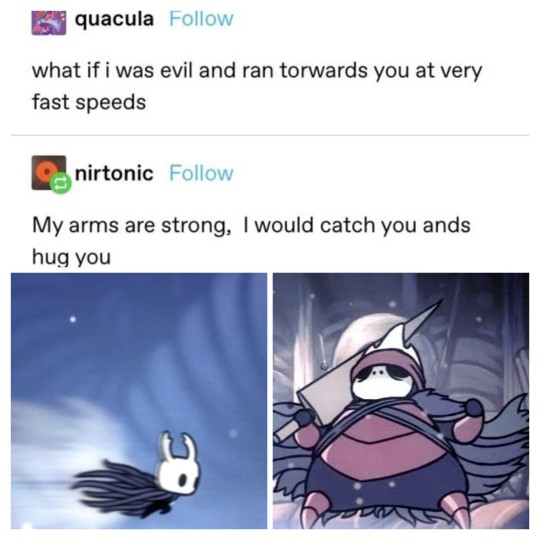



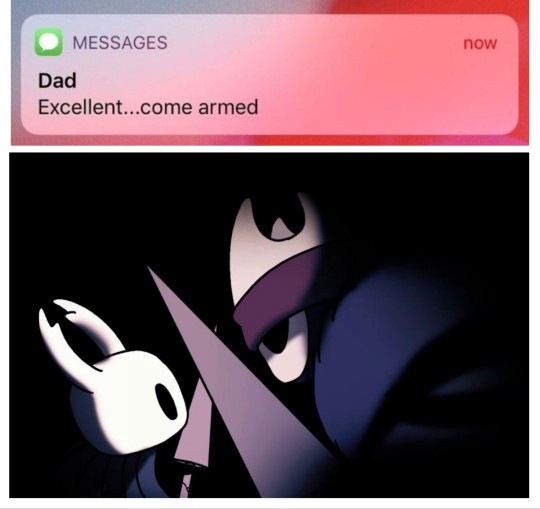
Hk textposts Mato edition because I love him
700 notes
·
View notes
Text
Round 3 - Reptilia - Apodiformes



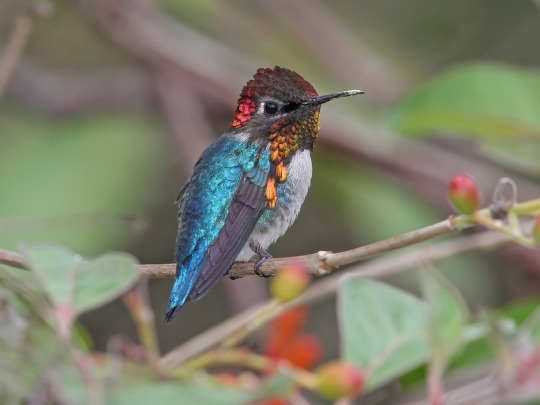
(Sources - 1, 2, 3, 4)
Our final strisorean order is the Apodiformes, which is divided into three living families: Apodidae (“swifts”), Hemiprocnidae (“treeswifts”), and Trochilidae (“hummingbirds”).
The Apodiformes are the most derived strisorean birds, and the second most diverse order of birds in general. Like their relatives, they have small, weak legs and feet. But that is where most of the similarities to their relatives end. Apodiformes are skilled fliers, being some of the most agile living birds. The hummingbirds are capable of hovering and even flying backward, while the swifts are some of the fastest flying birds in the world. Swifts and treeswifts eat insects which they catch on the wing, while hummingbirds have long beaks adapted for drinking nectar (though they eat small insects as well).
Swifts have unique nesting behavior, gathering to nest in caves, on cliff walls, or in human-made “caves” such as chimneys. While some species nest in holes and small cavities in walls, many species of swift glue their nest to a vertical surface using sticky saliva. The male typically builds the nest, but both parents raise the young. Treeswifts will glue their nest to an open tree branch, with nest-building responsibilities shared by both parents. Meanwhile, hummingbirds build small, cup-shaped nests out of lichen and spider silk, and the males do not take part in parental responsibilities. Apodiformes have small clutches, ranging from 1-3 eggs at a time, depending on species.
The Apodiformes share a clade, Apodimorphae, with the owlet-nightjars (Aegotheliformes), which branched off from the other strisoreans in the Early Eocene. It is thought that the owlet-nightjars and the apodiformes diverged shortly after this.

Propaganda under the cut:
The swiftlets (tribe Collocaliini) have developed a form of echolocation for navigating through dark cave systems where they roost (the only other bird known to echolocate is the similarly cave-roosting Oilbird).
The resemblance between swifts and the (unrelated) swallows is due to convergent evolution, where both bird families developed similar anatomy due to similar life styles based on catching insects in flight.
The White-throated Needletail (Hirundapus caudacutus) is a large swift that is reputed to reach speeds of up to 170 km/h (105 mph) in horizontal flight.
The hardened saliva nests of the Edible-nest Swiftlet (Aerodramus fuciphagus) and the Black-nest Swiftlet (Aerodramus maximus) have been used in Chinese cooking for over 400 years, most often as “bird's nest soup”. Over-harvesting of this expensive delicacy has led to a decline in the numbers of these swiftlets in some areas, and the nests can fetch high prices. In Indonesia and Malaysia, the nests are “farmed” in purpose-built structures or old empty houses with "tweeters" playing recordings of bird calls on the roof to attract swiftlets to the nest area.
Some species, like the Chimney Swift (Chaetura pelagica), hunt in mixed species flocks with other aerial insectivores like swallows.
Hummingbirds are called so because of the humming sound created by their rapidly beating wings, which flap at high frequencies audible to other birds and humans. Wing-flapping rates vary from around 12 beats per second in the largest species to 99 beats per second in small hummingbirds.
Hummingbirds have the highest mass-specific metabolic rate of any homeothermic animal. To conserve energy when food is scarce and at night when not foraging, they can enter torpor, a state similar to hibernation, and slow their metabolic rate to 1⁄15 of its normal rate.
The 8 cm (3 in) long Rufous Hummingbird (Selasphorus rufus) has one of the longest migrations among birds, traveling twice per year between Alaska and Mexico, a distance of about 3,900 miles (6,300 km).
Lesbiini (“coquettes”) is one of the two tribes that make up the subfamily Lesbiinae in the hummingbird family. Lesbiini contains such genera as Sappho, Taphrolesbia, and Lesbia.
Aztecs wore hummingbird talismans, artistic representations of hummingbirds, and fetishes made from actual hummingbird parts as emblematic for vigor, energy, and propensity to do work along with their sharp beaks that symbolically mimic instruments of weaponry, bloodletting, penetration, and intimacy. Hummingbird talismans were prized as drawing sexual potency, energy, vigor, and skill at arms and warfare to the wearer. The Aztec god of war Huitzilopochtli is often depicted in art as a hummingbird. Aztecs also believed that fallen warriors would be reincarnated as hummingbirds.
The Bee Hummingbird (Mellisuga helenae) is the smallest known bird, and the smallest known dinosaur of all time. Females weigh 2.6 g and are 6.1 cm (2.4 in) long, and are slightly larger than males, which have an average weight of 1.95 g and length of 5.5 cm (2.1 in).
When courting, the male Anna's Hummingbird (Calypte anna) ascends to around 35 m (115 ft) above a female, before diving at a speed of 27 m (89 ft) per second, equal to 385 body lengths/sec – producing a high-pitched sound near the female at the nadir of the dive. This intentional downward acceleration during a dive is the highest reported for any vertebrate; in addition to acceleration, the speed relative to body length is the highest known for any vertebrate. For instance, it is about twice the relative diving speed of the Peregrine Falcon (Falco peregrinus) in pursuit of prey. At maximum descent speed, about 10 g of gravitational force occur in the courting hummingbird during a dive.
The Strisores clade really went the extra mile with their birds. You got bats, tree stumps, Literally A Bat, frogs, owls again, and bugs. Hummingbirds are dinosaurs that decided to become bugs. I love this planet.
#reblog#animal polls#WOOOOO LOVE YOU HUMMINGBIRDS AND SWIFTS#oh my gog. lessbeans......#I keep thinking I don't have a favorite bird and then I keep getting reminded that there are So Many delightful birds that I love so dearly
85 notes
·
View notes
Text



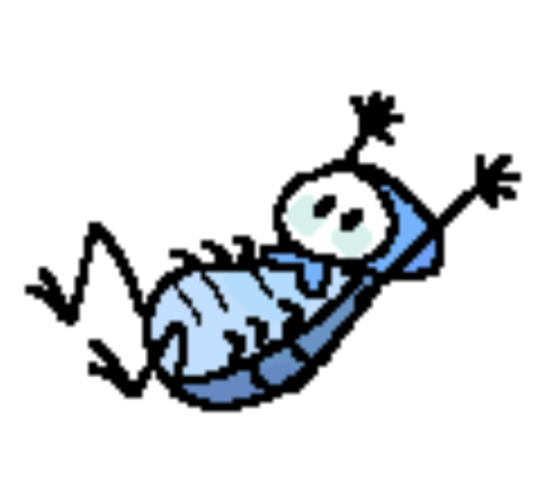
Phone doodles to figure them out again
3K notes
·
View notes
Text
Round 3 - Reptilia - Aegotheliformes
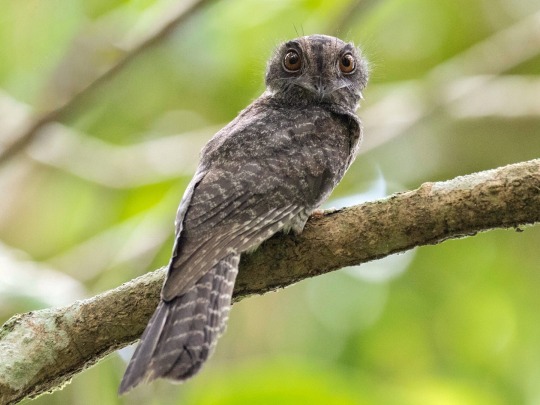

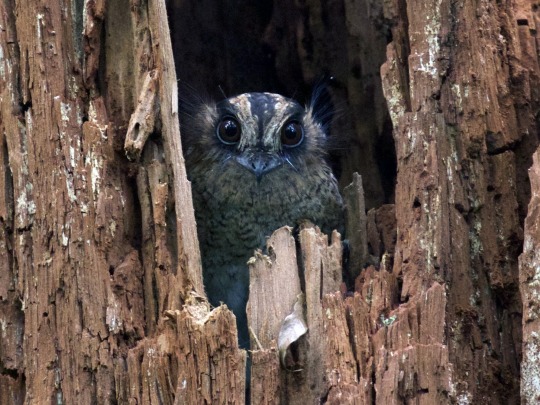

(Sources - 1, 2, 3, 4)
Our next strisorean order is Aegotheliformes, commonly called “owlet-nightjars”. This order contains one family, Aegothelidae, and one genus, Aegotheles, with 10 living species.
Owlet-nightjars are small strisoreans, which are crepuscular (active at dawn and dusk) rather than nocturnal. During the day they roost in holes in trees. They are insectivores which usually hunt in the air on short wings, sitting on a perch and waiting to dive down onto passing insects. Their feathers are soft, and mainly cryptic browns and tans. Their feet are small and weak, but comparatively larger and stronger than those of nightjars and frogmouths. Their wide mouth is tipped by a small bill and surrounded by prominent rictal bristles. Most owlet-nightjars are native to New Guinea, but some species exist in Australia, the Moluccas, and New Caledonia.
Owlet-nightjars are usually solitary, except during breeding. They mainly nest in holes in trees. Both the male and female will line the nest with leaves. The female will lay 2-4 eggs and is the only parent to incubate them. Both parents feed the chicks, which fledge after a month. The young birds may stay close to the parents for several months after they fledge.
Strisores have a well-represented fossil record, with fossils of most major strisorean lineages known from the Paleogene. Strisores evolved in the Eocene, with the two main extant lineages of separating about 60–55 million years ago. Owlet-nightjars, while once thought to be closer to either nightjars or frogmouths, actually share a more recent common ancestor with the Apodiformes (“hummingbirds” and “swifts”), which branched off from the other strisoreans in the Early Eocene. It is thought that the owlet-nightjars and the apodiformes split from each other shortly after this.

Propaganda under the cut:
The New Zealand Owlet-nightjar (Aegotheles novaezealandiae) was once the largest owlet-nightjar, and was known by the Māori as Ruru hinapō. Like most other New Zealand birds it is suspected to have been flightless or minimally flighted. The New Zealand Owlet-nightjar went extinct in the late 13th century, likely due to the invasive Pacific Rat (Rattus exulans), which arrived in New Zealand with Polynesian settlers.
The largest (maybe) living owlet-nightjar is now the New Caledonian Owlet-nightjar (Aegotheles savesi). This large owlet-nightjar is only known from two specimens taken in 1880 and 1915, two other confirmed sightings, two partly disputed sightings, and one unconfirmed debated sighting. The most recent report is from a 1998 expedition which saw a large nightjar foraging for insects at dusk in Rivière Ni Valley. This suggests that the species may still survive in small numbers, but the total population is likely very small and declining.
The Australian Owlet-nightjar (Aegotheles cristatus) is also known as the “Moth Owl”.
The Australian Owlet-nightjar will frequently add Eucalyptus leaves to its nest. It is thought that this may be done as a form of natural insecticide, to keep biting insects away from the eggs and chicks.
60 notes
·
View notes
Text
Round 3 - Reptilia - Caprimulgiformes
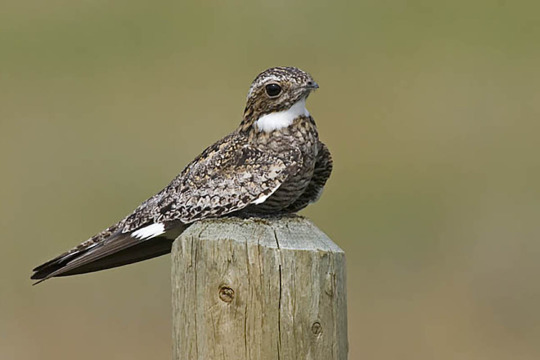

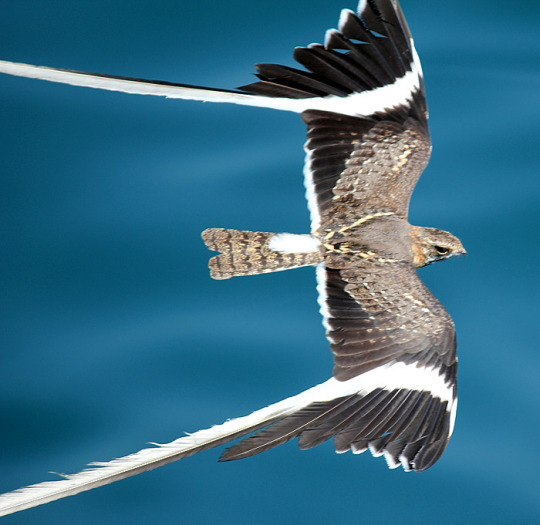

(Sources - 1, 2, 3, 4)
As we move into the Strisores clade, our next order are the Caprimulgiformes, commonly known as “nightjars”, “bugeaters”, or “nighthawks”. Caprimulgiformes is composed on one family, Caprimulgidae, and 19 genera.
Nightjars are medium-sized nocturnal or crepuscular birds, characterised by long pointed wings, short legs with small feet, and short beaks at the tip of a large mouth. Their primary source of food are night-flying insects, and they fill a similar role to insect-eating bats. Nightjars usually catch their prey by flying through insects with their wide mouths open. They have soft, cryptic plumage, allowing them to camouflage against trees while they sleep during the days. They have rictal bristles around their beak which function similarly to whiskers. Nightjars live on all continents except Antarctica, and some islands, in almost all habitats aside from the most arid deserts.
Nightjars are generally solitary, but will form flocks for the purpose of migration and/or for mating displays. They usually nest on the ground, laying one or two patterned eggs directly onto bare ground. It has been suggested and quoted that nightjars can move their eggs and chicks from the nesting site in the event of danger by carrying them in their mouths, but there is little evidence to support this idea. The nocturnal and secretive nature of nightjars makes it hard to study their behavior. It is unknown whether nightjars mate for life, but they are monogamous for the duration of the mating season.
Strisores have a well-represented fossil record, with fossils of most major strisorean lineages known from the Paleogene. Strisores evolved in the Eocene, with its two main extant lineages separating about 60–55 million years ago. At around 40 mya, the common ancestors of Caprimulgidae and Nyctibiidae diverged from those of the oilbird and frogmouths.

Propaganda under the cut:
The Common Poorwill (Phalaenoptilus nuttallii) is one of the only birds that undergoes a form of hibernation, becoming torpid and with a much reduced body temperature for weeks or months. Other nightjars can also enter a state of torpor, but for shorter periods.
The European Nightjar (Caprimulgus europaeus) is also known as the Common Goatsucker. This, along with their genus name, refers to an old myth that it would suckle from goats at night, causing them to cease to give milk. (Nightjars do not do this)
Nightjars have a reflective tapetum lucidum at the back of their eyes, causing their eyes to “glow” when lit up at night.
Nightjars do almost everything on the wing, including eating and drinking.
Several comic book heroes use the pseudonym “nighthawk”, including the detective Nelson Lee in “The Nelson Lee Library”, a Harvey Comics superhero, the cowboy Hannibal Hawkes in the DC Comics Universe, and several characters within the Marvel Comics Universe. In fact, there is an abundance of media using the name “nighthawk”, from art pieces, to films, to music, to sports teams, to racehorses, to aircraft, motorcycles, firearms, and amusement park rides. It’s possible that many of the people using this name only know that the nighthawk is a nocturnal bird, and not so much that it’s a small, big-mouthed, insect-eater.
96 notes
·
View notes
Text
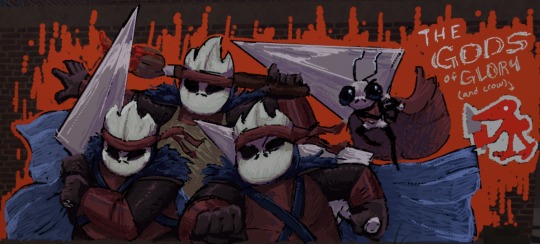
I BEAT THE THIRD PANTHEON LETS GOOOOOOO
also yes I drew this in Roblox, it’s surprisingly good at fixing art block
(Someone else drew the crow and I decided to add him to the group, plus I gave him his own nail ✨)
81 notes
·
View notes
Text
Trying to get back into pmv/animatic making. We should bring Vines back tbh
1K notes
·
View notes
Text
Round 3 - Reptilia - Gruiformes
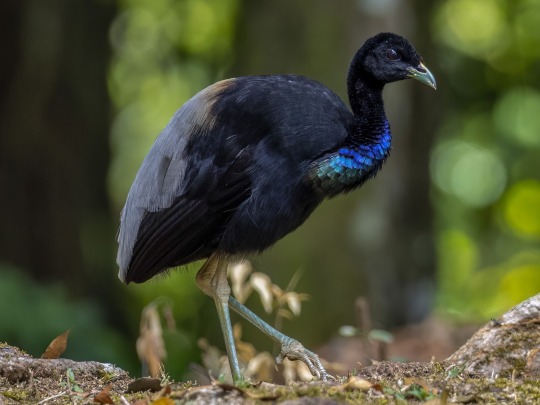
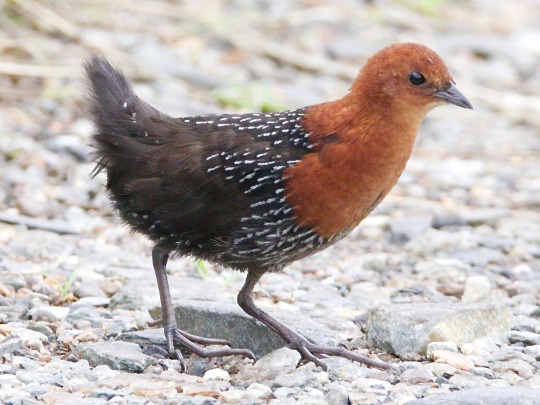
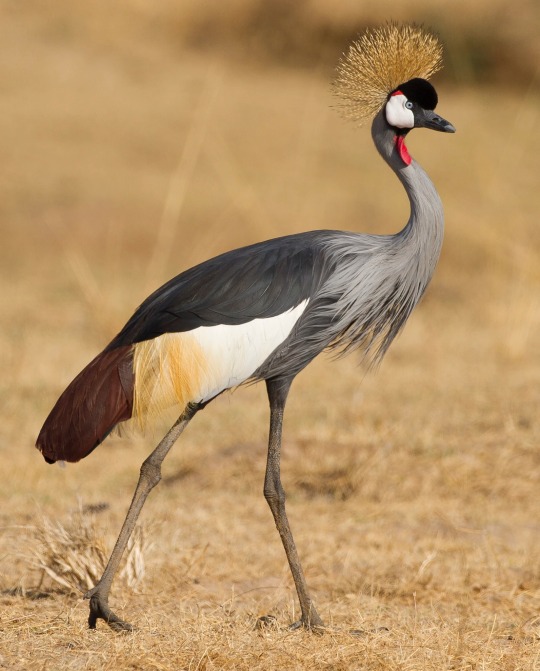

(Sources - 1, 2, 3, 4)
Our next order of birds are the Gruiformes, a diverse order with a widespread geographical diversity. “Gruiform” means “crane-like”, even though the majority of gruiformes are rails. Gruiformes contains the families Psophiidae (“trumpeters”), Aramidae (“Limpkin”), Gruidae (“cranes”), Rallidae (“rails”, “coots”, and “crakes”), Heliornithidae (“finfoots”), and Sarothruridae (“flufftails”).
Gruiformes are terrestrial or wading birds with a considerable amount of diversity. The Trumpeters (genus Psophia) (image 1) are rotund birds with long, flexible necks and legs, downward-curving bills, soft plumage, large eyes, and a “hunched” appearance. They are weak fliers but fast runners, and can also swim across rivers. The cranes (Gruidae) (image 3 and gif below) and the Limpkin (Aramus guarauna) are long-necked, long-legged, long-beaked waders, some of which are the world’s tallest flying birds. Their plumage varies by habitat. The Rallidae (image 4) are the most diverse family of Gruiformes. Many are associated with wetland habitats, some being semi-aquatic like waterfowl (such as the coot), and some being more like wading birds or shorebirds. The finfoots (Heliornithidae) resemble rails; they have long necks, slender bodies, broad tails, and sharp, pointed bills. Their legs and feet are brightly coloured and they are capable of walking well and even moving quickly on land. The flufftails (Sarothruridae) (image 2) are small- to medium-sized ground-living birds. Due to the diversity of this order, it is difficult to summarize them further!
Gruiformes evolved in the Paleocene, around 60 million years ago.
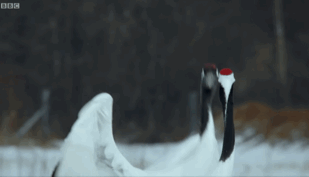
(source)
Propaganda under the cut:
Grey-winged Trumpeters (Psophia crepitans) are polyandrous and cooperative breeders. Up to three males mate with the dominant female of the flock, and all members of the flock contribute to raising the young.
One of the handful of non-avian dinosaurs we know the colors of is the Late Jurassic Caihong juji. Thanks to some exquisitely fossilized melanosomes (pigment cells) within the animals feathers, paleontologists were able to determine Caihong’s coloration by comparing it to those of living birds. The sheets of platelet-like melanosomes were solid and lacked air bubbles, and were thus most similar to the iridescent feathers that exist in modern Trumpeters (genus Psophia). It is thanks to trumpeters for preserving this type of melanosome, that we know the appearance of a dinosaur from the Late Jurassic!
The Limpkin (Aramus guarauna) has a beak that is slightly open near the end, giving it a tweezer-like action to remove their main prey, Apple Snails (family Ampullariidae), from their shells. In many individuals the tip of their beak curves slightly to the right, matching the Apple Snails’ shells.
Most species of cranes have been affected by human activities and are at the least classified as threatened, if not critically endangered. The plight of the Whooping Crane (Grus americana) of North America inspired some of the first US legislation to protect endangered species. After being pushed to the brink of extinction due to unregulated hunting and loss of habitat, just 21 wild (and two captive) Whooping Cranes remained by 1941. Thanks to conservation efforts, the total number of cranes in the surviving migratory population, including those in captivity, only slightly exceeds 911 birds as of 2020.
The Sanskrit epic poet Valmiki was inspired to write the first śloka couplet by the pathos of seeing a male Sarus Crane (Antigone antigone) shot while dancing with its mate.
The endangered South Island Takahē (Porphyrio hochstetteri) is a flightless swamphen indigenous to New Zealand. Takahē were hunted extensively by both early European settlers and Māori, and takahē's bones, as well as fossil remains, have been found in middens in the South Island. They were not named and described by Europeans until 1847, and then only from fossil bones. In 1850 a living bird was captured, and three more collected in the 19th century. After another bird was captured in 1898, and no more were to be found, the species was presumed extinct. Fifty years later, however, after a carefully planned search, South Island Takahē were dramatically rediscovered in November 1948 by Geoffrey Orbell in an isolated valley in the South Island's Murchison Mountains. Since then, takahē have been reintroduced to numerous locations across the country. As of 2023, the population is around 500 and is growing by 8% per year.
The Guam Rail (Hypotaenidia owstoni) came perilously close to extinction when Brown Tree Snakes (Boiga irregularis) were introduced to Guam, but some of the last remaining individuals were taken into captivity and have been breeding well. They have since been successfully introduced to the nearby Rota and Cocos islands, as the Brown Tree Snakes have yet to be eradicated in Guam. In 2019, the Guam Rail became the second bird species to be reclassified by the International Union for the Conservation of Nature from Extinct in the Wild, to Critically Endangered.
82 notes
·
View notes
Text
Round 0
@bestanimal
“it's a really cool concept!!!!”
@poorly-identifying-cats-in-posts
(no propaganda submitted)
#reblog#guys guys guys help guys help guys#bestanimal is the tournament I've been obsessed with for the past like year please please please#it's so good#also this might help it gain more traction idk
81 notes
·
View notes
Text



Bugaboo Pocket released today on Steam! (Will be out on switch later 2025).
I’ve been excited about this game now for over a year! If you loved tamagatchi’s as a kid, you’ll love this game! You get to raise your very own digital pet insects, dress them up, and decorate their homes! 🐛
15K notes
·
View notes
Text

found family trope. and I think I finally may have found a doodle/messy style!
#reblog#hollow knight#tiso#hk ghost#hk hornet#going insane /pos#I should scroll through hk blogs more often
582 notes
·
View notes